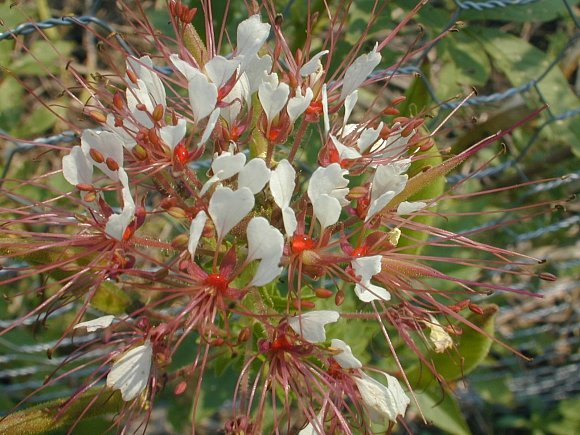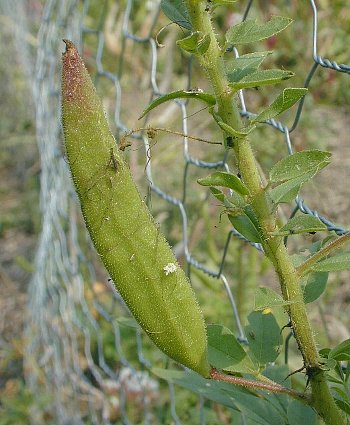Description: This annual plant is about 2' tall and largely unbranched, except near the base. The major stems are stout, round, and covered with rather long glandular hairs, especially where new growth occurs. The lower and middle compound leaves along the stems are trifoliate with long petioles. The individual leaflets are about 1½" long and ½" across. They are oval, ovate, or oblong, and have smooth margins that are slightly ciliate. Their surface is dull green and covered with short fuzzy hairs, with longer hairs occurring along the lower central vein. When the foliage is bruised or rubbed against, a fetid odor is emitted. Smaller leaves on short petioles occur along the upper stems that are simple, rather than compound. The major stems terminate in racemes of flowers of variable length – these flowers are whorled near the apex of the stems with scattered seedpods below. Each flower is about 1" across and has an unusual structure. There are 4 white petals about ½" long that are heart-shaped, but with a long narrow base. About 8-12 strongly exerted stamens are reddish purple and rather unequal in length, with the upper stamens about twice the length of the petals. The single slender style is much shorter than the stamens and less conspicuous. At the base of each flower, is a gland that secretes a conspicuous drop of bright red fluid. The calyx is divided into 4 triangular sepals that are reddish purple. The flowers occur on long hairy pedicels.

The blooming
period occurs from summer until the fall, and can last several months.
There is no obvious floral scent. Pollinated flowers develop sizeable
seedpods up to 3" long that are sessile against the pedicels (i.e.,
there is no stipular growth at the base of the seedpods). These
seedpods resemble stout bean pods that can divide into two halves. Each
seedpod has fuzzy hairs on the outer surface, and forms a long terminal
spike that withers away as the seedpod matures. Mature seedpods are
held more or less erect, rather than drooping downward from the stems.
The individual seeds have an irregular patterned surface. The root
system consists of a long taproot without rhizomes. This plant spreads
by reseeding itself.
Cultivation:
It is best to growth this plant in full sunlight, mesic to dry
conditions, and soil that is rocky or sandy. The base of the central
stem of this plant may sprawl along the ground if it is grown in moist,
fertile soil. Foliar disease and insect pests are not generally
troublesome.

Range &
Habitat:
Large-Flowered Clammyweed is an uncommon plant that occurs in widely
scattered counties in Illinois (see Distribution
Map), where it is probably native. This plant is more common
in areas that lie to the west of
Illinois. Within the state, it has been found in such natural habitats
as openings in bluffs, glades, or hill prairies, and may occur
occasionally as an
adventive plant along railroads. Because of the ornamental flowers,
this plant can be found in flower gardens, but this is uncommon.
Faunal Associations:
Various bees visit the flowers for nectar, while flower flies feed on
the pollen from the exerted anthers. However, the latter group of
insects does not effectively pollinate the flowers. The foliage is not
known to be toxic to mammalian herbivores, notwithstanding the fetid
odor, but little appears to be known about the attractiveness of the
foliage as a food source. Similarly, little is known about the
attractiveness of the seeds to small rodents or upland gamebirds.
Because the seeds of similar kinds of plants, such as the Cleome
spp. (Bee Plants) in the western states, are occasionally
eaten by the Ring-Necked Pheasant, Mourning Dove, and various small
rodents, it is possible that the same or similar species also eat the
seeds of Polanisia spp. (Clammyweeds).

Photographic
Location:
The edge of vegetable garden in Meadowbrook Park, Urbana, Illinois. The
plant was blooming during early September.
Comments:
Large-Flowered Clammyweed is primarily a western species, and Illinois
lies on the eastern edge of its distribution. It is fairly attractive
while in bloom and has some resemblance to Cleome hassleriana
(Spider Flower) of mass-market horticulture. This latter species is a
larger plant from South America with palmate compound leaves. The more
typical variety of Clammyweed, Polanisia dodecandra dodecandra,
has smaller flowers with petals about ¼" and stamens that are barely
longer than the petals. It less showy than the variety of Clammyweed
that is described here, and it has a more eastern distribution. An
uncommon species of Clammyweed, Polanisia jamesii
(James' Clammyweed), is a sand prairie species that has narrow leaflets
and flower petals with irregular fringed edges. What distinguishes the Polanisia
spp. (Clammyweeds) from the Cleome spp.
(Bee Plants) is the lack of a stipe connecting the seedpod with the
pedicel. This stipe of the Bee Plants is a stalk-like extension of the
developing seedpod. Both groups of plants are members of the Caper
family.